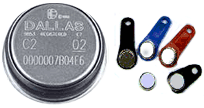 |
 Magnetic Stripe
Magnetic Stripe
Magnetic Stripe cards (commonly known as “magstripe”) typically come in a ‘credit card’ size. An emulsion is bonded to the card and this may be encoded with data. Magstripes are inherently secure, inexpensive, and familiar. However the data is susceptible to corruption from magnetic fields. The reading mechanism requires contact with the card therefore abrasion may also prematurely render a card unusable.

Media cost: Inexpensive
Normal minimum life: 2 years
Recommended environment: clean, non-dusty

  Barcode
Barcode
Barcode technology has been around for many years. Barcodes are a versatile and reliable medium. Reading mechanisms are non-contact, making barcodes ideal for dusty environments. On the down side, they are basically insecure, ie; it is not hard to produce a barcode using a PC and barcode software.
Media cost: Inexpensive
Normal minimum life: 2 years
Recommended environment: any


 Proximity Cards
Proximity Cards
Proximity Cards use radio techniques to communicate with a transciever reader unit. Each card has a unique I.D. number which is encoded. The card is simply passed or waved near the reader. They are often used for access control.
Media cost: More expensive
Security: Very secure
Through put: Very fast
Normal minimum life: 10 years
Recommended environment: all – depends on specific card design


 Touch Memory
Touch Memory
Touch Memory I.D. buttons are like smart cards – in that they use an embedded silicon chip with a unique I.D. The button is no bigger than four 5 cent pieces stacked together, and they are very secure and robust. The buttons are fitted to key fobs making them highly portable.
Media cost: more expensive
Through put: fast
Normal minimum life: 10 years
Environment: any


 Biometrics
Biometrics
Simply put, Biometrics is the science of using body parts as the I.D. media. For instance, a persons iris, fingerprints, voice, or hand could be used to identify that individual. We believe hand recognition to be the most reliable and effective. The hand reader takes three digital images of your hand and stores this with a pin number. Subsequent readings require entry of the pin number followed by hand placement. The new image is compared to the stored images and a match records a transaction.
Media cost: nil
Security: most secure
Through put: slowest
Environment: clean

|
